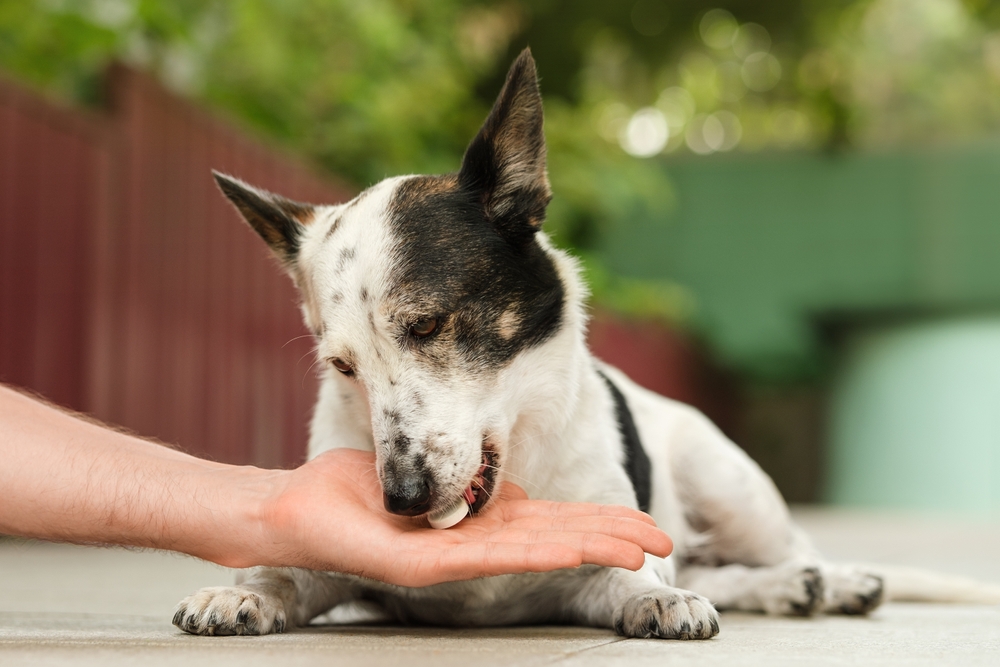In this article
A seizure is one of the most frightening things that we pet owners can witness our precious pups going through. It can make us feel completely helpless and in certain circumstances, can even cause harm to our canine companions. So, it’s no wonder that you will want to work with your vet to stop or at least decrease the number of seizures that your dog has.
However, choosing a seizure medication isn’t as simple as picking the most colorful label on the shelf. Instead, your vet will put a great deal of thought and potentially even trial and error into deciding which one(s) to try. Here’s more info on the most common seizure medications for dogs.

What Are Seizure Medications for Dogs?
Seizures are caused by a disruption in normal brain electrical activity. They are most commonly brought on by a disease called epilepsy, but they can also occur due to things like toxins, brain tumors or abscesses, brain trauma, viral infections, and even liver disease and low blood sugar, to name a few.
A seizure caused by anything other than epilepsy is best managed by treating the underlying issue. For an epileptic dog, occasional seizures typically aren’t treated, but your vet will look into treatment for those happening more frequently, such as more than once per month. The most common treatment is seizure medication.
Some medications are used to help prevent or reduce the number of seizures, while others are given during the episode to help decrease the intensity and duration of the convulsions. For the best results, some dogs may require a seizure medication “cocktail,” which includes multiple drugs.


The 5 Common Seizure Medications for Dogs
1. Phenobarbital
| Type of Medication: | Barbiturate |
| How It’s Given: | Pill, paste, liquid, injection |
| Potential Side Effects: | Lethargy, sedation, anxiety, agitation, increased appetite and water consumption, incoordination |
Phenobarbital is the main seizure medication for canines. Nearly every dog diagnosed with epilepsy has tried this drug at one point or another. While phenobarbital has a decent track record for reducing seizures, the list of side effects and drug interactions often makes treating with it a balancing act.
It’s important to note that irregular dosing or missing a dose of phenobarbital can actually trigger seizures, so sticking to a strict medication schedule is vital. Also, dogs on other medications, such as certain antibiotics, heart medications, or steroids, and dogs with liver disease shouldn’t take phenobarbital.
2. Potassium Bromide
| Type of Medication: | Bromide |
| How It’s Given: | Pill, liquid |
| Potential Side Effects: | Sedation, nausea, increased thirst and urination |
Potassium bromide is a common seizure medication that can be used alone, especially in dogs that have experienced negative side effects when taking phenobarbital, or it can be used together with phenobarbital when one drug alone won’t keep seizures at bay.
Potassium bromide tends to have fewer side effects than phenobarbital while still providing adequate seizure control. It does take a while to build up effective levels in the body, so a large loading dose is often given for the first few days of treatment.

3. Levetiracetam
| Type of Medication: | Anticonvulsant |
| How It’s Given: | Pill, liquid, injection |
| Potential Side Effects: | Sleepiness, incoordination, decreased appetite, drooling, changes in behavior |
Levetiracetam is a relatively new seizure medication being used by itself in dogs that had issues with either phenobarbital or potassium bromide. It can also be used in combination with those to better work for a dog’s seizures.
Levetiracetam is typically well tolerated and may allow a decrease in the dosage of other seizure medications in order to reduce unwanted side effects. There is currently only limited research on it, but that is likely to change as more and more dogs find relief while using it.
4. Zonisamide
| Type of Medication: | Anticonvulsant |
| How It’s Given: | Pill |
| Potential Side Effects: | Sedation, vomiting, diarrhea, decreased appetite, incoordination |
A new medication that is making its way into veterinary seizure medications is zonisamide. This is similar to levetiracetam in that it can be used alone as a second (or third or fourth) chance for dogs that didn’t fare well on phenobarbital or other seizure medications, or it can be used in combination with others in order to increase its efficacy while decreasing the side effects.
While this medication does appear to have usefulness, more research needs to be done, and more dogs need to use it to get the full story.

5. Diazepam and Other Benzodiazepines
| Type of Medication: | Benzodiazepine |
| How It’s Given: | Pill, injection, suppository, intranasally |
| Potential Side Effects: | Sedation, muscle weakness |
Diazepam and similar medications aren’t for everyday use in dogs that experience seizures. Rather, they should be given while a dog is seizing to help reduce the convulsions. Some vets will give dog owners an emergency dose to have on hand should their dog have multiple or severe seizures. It can be given by an injection or as a suppository in the rectum. Diazepam’s muscle relaxant and sedative abilities can help quiet a dog’s seizures to help avoid any negative consequences.

What Are Refractory Seizures in Dogs?
With any luck, your pup will find seizure relief from one or a combination of these seizure medications, but some dogs aren’t so lucky. They will experience seizures that still pop up even when they’re on a consistent and often previously effective treatment plan. These are called refractory seizures and may come about due to the dog’s body becoming less responsive to the medications.
In these cases, additional seizure medications can be tried, including drugs like gabapentin, pregabalin, imepitoin, or topiramate. Non-medication treatment, including CBD, acupuncture, or changes in diet may also help.
Seek veterinary advice if you’re concerned about your pet’s well-being.
If you need to speak with a vet but can't get to one, head over to PangoVet. It's our online service where you can talk to a vet online and get the advice you need for your dog — all at an affordable price!
How Are Dogs on Seizure Medications Monitored?
Epilepsy is a lifelong disease. Dogs don’t grow out of it or become miraculously cured. You’ll need to get their seizure medications for the long term. As we all know, the longer that dogs tend to take any kind of medication, the increased risk there is for side effects. Seizure medications are no different. Your vet will schedule frequent and regular check-ins to see how your dog’s body is handling the medication.
These check-ins will typically include blood work to check organ function and medication levels in the blood. Your vet will also want to know about your dog’s seizure activity—or hopefully, lack thereof—along with any side effects that you may have noticed. With this knowledge, they can adjust doses or add or subtract medications as needed to best manage your dog’s seizures with minimal side effects.


In Conclusion
Seizures in dogs can be a scary thing to witness and a difficult thing to get a handle on. Fortunately, there are many seizure medications out there that can be used alone or in combination to best reduce seizures while hopefully leading to few side effects.
Since a successful seizure medication is likely a long-term part of your dog’s life, regular monitoring will be required by your vet to make sure you are providing the best care possible for your canine companion.
Featured Image Credit: fast-stock, Shutterstock



















3 Responses
Madam Good afternoon,
My self Dr. Pulin Barai from India. My furrbaby is a beagle male 2.3 years age. When he was only 9 months, suddenly he experienced seizure. After that occasions he is getting seizure in every month moth or before. We have tried the medicines given by the local vets. Presently we are giving Gardinal 30 and Levipril 250 daily but no improvement. From yesterday he has experience more than 30 seizure with in 24 hours. what to do. kindly suggest.
Hi Pulin,
I’m really sorry your Beagle is going through this, that sounds extremely serious and frightening. Experiencing 30 seizures in 24 hours is considered a medical emergency and can be life-threatening.
You need to seek immediate veterinary care at an emergency clinic right now, he cannot safely wait for advice online. Bring all his medications and a record of his seizure history with you. Prompt treatment from a veterinarian is critical to stop the seizures and stabilize him.
my dog is sick,and just had a seizure I need to get her to the vet witch vet will let me make payments